"Mondnacht" is described by Oskar Seidlin as Eichendorff's "most beautiful poem, one of the few perfect lyrical marvels in the German language."1 Schumann's universally beloved setting, "pure magic" in Gerald Moore's words,2 is equally prized as one of the true gems of the German art song literature (Fig. 1).
Figure 1.
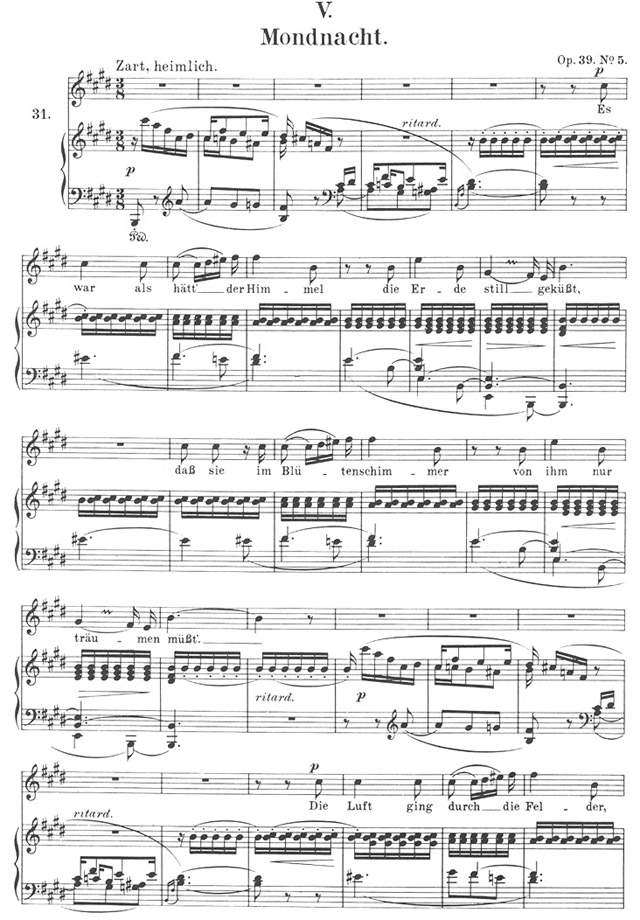
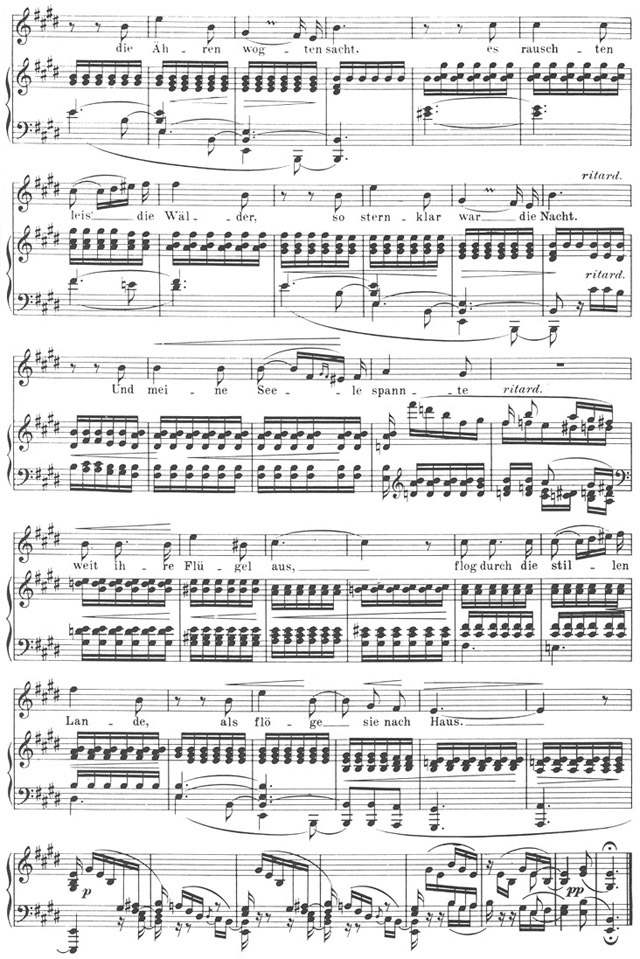
In this song, the composer matches the art of the poet in richness, nuance and form, creating a context in which verbal and musical elements embrace and reinforce one another. Such unified expression originates in a deeply sensitive and resonant reading of the text, and any investigation into the song must begin with an analysis of the inner motivations of the poem itself, its rhythms, themes, sound structures and dramatic shape.
"Mondnacht" Moon night
Es war, als hätt' der Himmel
Die Erde still geküsst
Dass sie im Blütenschimmer
Von ihm nur träumen müsst'.It was as if the heaven
the earth gently kissed,
that she in shimmering blossom
of him had only to dream.Die Luft ging durch die Felder
Die Ähren wogten sacht,
Es rauschten leis die Wälder,
So sternklar war die Nacht.The breeze went through the fields
the stalks waved gently,
the woods rustled softly,
so star-clear was the night.Und meine Seele spannte
Weit ihre Flügel aus,
Flog durch die stillen Lande,
Als flöge sie nach Haus.And my soul spread
wide its wings out,
flew through the quiet regions,
as if it were flying home.
The poem scans in iambic trimeter, its twelve lines dividing into three quatrains each composed of a single sentence. Each pair of even numbered lines ends with perfect rhyme, while odd numbered pairs terminate slightly imperfectly. Against the consistent iambic3 initiations of all the lines, a counterposing accentuation scheme is applied to their endings. Odd numbered lines finish with an accentuation pattern of  , while even lines stop with the pattern
, while even lines stop with the pattern  . The alternation of these opposing units builds a current of subtle tension into the poem, a feeling of gentle movement that corresponds to Schumann's quietly pulsating sixteenth notes.
. The alternation of these opposing units builds a current of subtle tension into the poem, a feeling of gentle movement that corresponds to Schumann's quietly pulsating sixteenth notes.
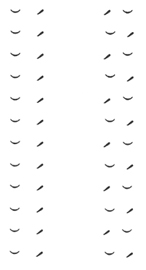
These features create the musical undercurrent for the poem, over which more determined and pronounced effects are introduced and developed. Egon Schwartz points to the captivating progression of what he calls vowel rows in the first four lines, a ä i, e i ü, i ü i, i äu ü, as a difficult-to-specify device of rhythmic and symphonic intensity.4 "Symphonic" refers to the parallel between a blend of diverse vowel colors and diverse timbres in orchestral music. Similar alliterative progressions also occur. The succession rauschten - sternklar - spannte starting in the seventh line offers a clear example. Even more powerful is the transformation in lines ten through twelve of the word root associated with flight: Flügel - flog - flöge. The modulation from noun to verb and then to subjunctive verb form achieves an amazing effect of object becoming action becoming abstraction. Even more striking is the dynamic succession of key verbs covering all three quatrains. These verbs, carefully placed to begin lines, link together in a progression that results in a musical crescendo: es war - es rauschten - flog.
Deeper complexities obtain in the arrangement of substantive and action words and the interplay of opposing noun genders. Up to the ending of the second quatrain, lines terminate alternately with noun and verb: Himmel, geküsst; Blütenschimmer, müsst; Felder, sacht; Wälder, Nacht. Line six closes with a verb modifier rather than a verb proper, and line eight ends with a noun, presumably to add cadence to the quatrain pair lines one through eight. The first two lines encapsulate this alternation, line one commencing with a verb form and finishing with a noun, line two reversing the order and starting with a noun, ending with a participle. The third quatrain sets itself off by augmenting the previous pattern, spreading the alternation over four lines rather than leaving it confined to two. Lines nine and ten both end with components of the separable verb ausspannen, while eleven and twelve both end with nouns.
As noun and verb alternate throughout the poem after the plan just described, progressive counterpoint between masculine or neuter nouns, and feminine nouns correspondingly unfolds. Nouns placed at the ends of lines are either masculine or neuter, except for the feminine Nacht at the end of line eight. Initial and internal nouns are feminine, except for the masculine Flügel in line ten. Lines three, four, and five exhibit peculiar traits. Line three uses the only compound substantive in the poem, Blütenschimmer, formed of two words, one feminine and one masculine. Line four contains no substantive; line five includes two nouns, the first feminine, the second masculine. The gender order of nouns is as follows: m, f, m, f; n, f, m, f; f, m, n, n. The first two quatrains adhere firmly to the pattern. The third quatrain adopts a new pattern, appropriate to its content and point of view. The double feminine signals the break from the old pattern.
Oscillation between iamb and trochee, noun and verb, masculine and feminine, is treated as a motif, and the cumulative movement between opposites produces a continuum, almost like a musical accompaniment, which gives life to the text. The theme of opposition then magnifies in imagistic relationships between air and fields, heaven and earth, rustling woods and still lands. Opposing elements are conjunctive rather than repellent, sympathetic rather than adversarial. They yearn to join with one another. Allusions to reproductive sexuality are strong, suggesting an allegory of life's sacred self renewal. The allegory becomes a metaphor for the polarity between flesh and spirit, and the culmination of the theme reflects this: the human soul yearning for reunion with the universal soul of the divine, the human essence expanding beyond earthly limits into the heavenly dimension.
Schumann reads the poem with profound receptiveness and appreciation. Lawrence Radner writes, "I would have the reader realize that Eichendorff's works rest upon the principle of the paradox,5 and Schumann is everywhere attuned to the multilevel dichotomies and oppositions at work in the text, and also to the ideas of yearning, expansion and surrender back into the source. With the very first impulse of the piano introduction Schumann begins to transfer the opposition motif into tones. Both registrally and intervallically a dichotomous relationship is set up between the low b—"earth-bound," as Gerald Moore calls it—and the high  —"its answer from the skies."6 Soon after, these tones, though dissonant with one another—gently dissonant, as they both share membership in the same dominant ninth chord—are brought into close and intimate proximity in a middle register. When the voice enters, the text setting is worked out so that phrase endings oppose one another. Himmel is declaimed with a descending perfect fifth (
—"its answer from the skies."6 Soon after, these tones, though dissonant with one another—gently dissonant, as they both share membership in the same dominant ninth chord—are brought into close and intimate proximity in a middle register. When the voice enters, the text setting is worked out so that phrase endings oppose one another. Himmel is declaimed with a descending perfect fifth ( to b) in the trochaic rhythm long-short (
to b) in the trochaic rhythm long-short ( ); geküsst, placed over a rising perfect fifth (e to b), answers iambically with a short-long (
); geküsst, placed over a rising perfect fifth (e to b), answers iambically with a short-long ( ). The dualism is strong, and yet the two gestures bear just as distinct common traits—they pivot around the same tone, and use the same interval. While the interval of the piano opening (b,
). The dualism is strong, and yet the two gestures bear just as distinct common traits—they pivot around the same tone, and use the same interval. While the interval of the piano opening (b,  ) and the vocal phrase endings express in music the notion of opposition, a further reference, much more conspicuous, occurs between the accompaniment and the voice with the peculiar cross relation e-
) and the vocal phrase endings express in music the notion of opposition, a further reference, much more conspicuous, occurs between the accompaniment and the voice with the peculiar cross relation e- . Of course, such relations are difficult to execute, are sometimes thought to sound unpleasant, and as a result are generally avoided. However, Schumann makes this example precious and builds it into the thematic fabric of the song to depict the paradox of opposition and synthesis: both tones have a common destination in pitches of the dominant arrival chord. To accomplish the feeling of yearning, Schumann reverses the conventional orientation of the music around tonic harmony. Instead of commencing phrases on I, he begins with dominant function chords. He keeps the music hovering by substituting a tonic arrival with harmonies involving the V7 of ii. Only in the middle of a phrase does the music touch upon the tonic. This creates a sense of anticipation, of perpetual search for the chord of repose and resolution. Ultimately the turn home is facilitated through the passage in the subdominant that takes up the third quatrain. A very positive confirmation of the E major tonic fulfills the prolonged dominant emphasis, and mirrors the textual notion of a spiritual return to God.
. Of course, such relations are difficult to execute, are sometimes thought to sound unpleasant, and as a result are generally avoided. However, Schumann makes this example precious and builds it into the thematic fabric of the song to depict the paradox of opposition and synthesis: both tones have a common destination in pitches of the dominant arrival chord. To accomplish the feeling of yearning, Schumann reverses the conventional orientation of the music around tonic harmony. Instead of commencing phrases on I, he begins with dominant function chords. He keeps the music hovering by substituting a tonic arrival with harmonies involving the V7 of ii. Only in the middle of a phrase does the music touch upon the tonic. This creates a sense of anticipation, of perpetual search for the chord of repose and resolution. Ultimately the turn home is facilitated through the passage in the subdominant that takes up the third quatrain. A very positive confirmation of the E major tonic fulfills the prolonged dominant emphasis, and mirrors the textual notion of a spiritual return to God.
Expansion is rendered by Schumann in a magnificent variety of ways. Increases in the number of notes in a chord, extension of range, widened spacing between parts, and rises in dynamic level convey the effect most immediately (see, for instance, mm. 10-12). The broadening of tempo by the ritard through measures 43-48 responds to that crucial moment when the word ausspannen ("expand") is heard in the text.
The voice-leading of the piano part en route to the phrase und meine Seele creates a marvelous sense of openness, and the introduction of new and ornamented melody here sends the music into new territory. Fusing the vocal line with the material of the piano motif at measure 47 makes an apotheosis, and the long duration for the  on the prefix aus stretches the emotion to a point of culmination. Finally, in measures 57-58 of the vocal part, the transformation of two bars of 3/8 into a single measure 3/4 brings the process to a close.
on the prefix aus stretches the emotion to a point of culmination. Finally, in measures 57-58 of the vocal part, the transformation of two bars of 3/8 into a single measure 3/4 brings the process to a close.
Eichendorff affects a dramatic shift in mood and direction at the turn into the last quatrain. The poet presents a dreamy landscape in the first two four line units—the subjunctive first describes the state of things, then the indicative further paints the scene. Suddenly, the focus changes in the last four lines. The soul of the beholder takes to action and his involvement with the previous images becomes clear. What seemed before to be static metaphors now sweep into a dynamic goal-directed surge. This stands out as one of those "momentous acts of awakening" that Seidlin refers to as as an idiosyncratic formula in Eichendorff's work.7 In every respect, Schumann's musical response supports and elaborates this poetic effect.
The music is not without finer points of text painting. Schumann's modifications of recurring accompanimental materials demonstrate this amply. By way of illustration, examine the new guise in which the music of the piano part at measure 8 (Fig. 2a) appears in bar 30 (Fig. 2b).
Figure 2a.
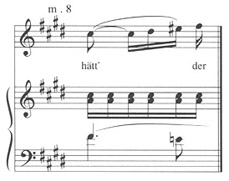
Figure 2b.
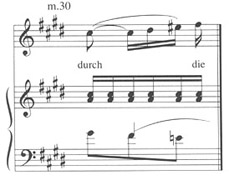
A  has been added in the first beat in the lower voice, and the
has been added in the first beat in the lower voice, and the  moved to the second beat. The imposition of the
moved to the second beat. The imposition of the  appoggiatura against the a one half step above as
appoggiatura against the a one half step above as  resolves downward to the
resolves downward to the  , suggests the movement of wind through branches and stalks mentioned at that moment in the text. Compare measure 7 (Fig. 3a) with its variant at measure 36 (Fig. 3b).
, suggests the movement of wind through branches and stalks mentioned at that moment in the text. Compare measure 7 (Fig. 3a) with its variant at measure 36 (Fig. 3b).
Figure 3a.
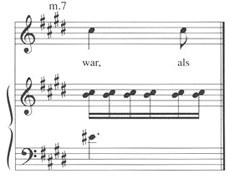
Figure 3b.
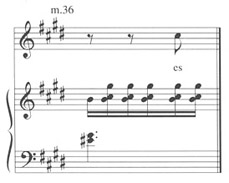
Then in measure 38 (Fig. 2c) we have a further variation on the material from bar 8.
Figure 2c.
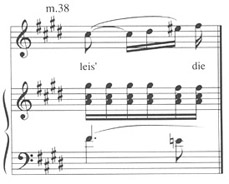
The new spacing and progression of parallel ninths expand the subtle agitation of the breeze. The image here is that of gentle rustling of the forest leaves, and the delicate leap to the chords in the right hand serves to mirror this. Unrest and urgency are yet more radically cultivated in measures 35-37 as, in comparison with the corresponding original passage measures 5-7, Schumann advances the entrance of the left hand  by one full bar. Following on, through measure 40, the accompanimental pattern recalls the starry dissonances of the splintering counterpoint in measure 2—the most intricate music in the piece—in preparation for the word sternklar coming in the text (Fig. 4).
by one full bar. Following on, through measure 40, the accompanimental pattern recalls the starry dissonances of the splintering counterpoint in measure 2—the most intricate music in the piece—in preparation for the word sternklar coming in the text (Fig. 4).
Figure 4.
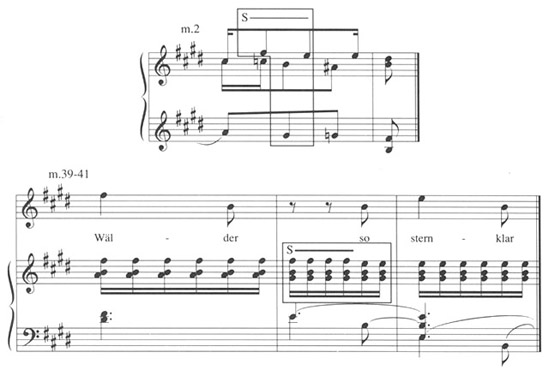
The celestial music of Eichendorff's poem is captioned by its title. Ironically, the moon is never mentioned in any way, and only two words in the course of twelve lines allude to the firmament: Himmel and sternklar. Yet moonlight illumines everywhere, spilling out from the heading "Mondnacht" suspended above the body of the poem. Schumann's poetic response is to render in tones Eichendorff's effect of beams lighting down from a source in the night sky. As rests cancel the heavy tones of the bass clef in measure 6, we drift in weightless suspension aloft. And as the  is struck on the next downbeat, a lunar body is placed in the sky, whose emanations cast a mellow light on all below.
is struck on the next downbeat, a lunar body is placed in the sky, whose emanations cast a mellow light on all below.  is the special note, one of two reserved for particular purposes in the song. Schumann saves the
is the special note, one of two reserved for particular purposes in the song. Schumann saves the  throughout the piano introduction for use in bar 7 to make the effect described. The other withheld tone is
throughout the piano introduction for use in bar 7 to make the effect described. The other withheld tone is  which is reserved until measure 47. It is saved to accentuate that dramatic turning point in the text where spiritual expansion occurs (to mark well, Schumann places it the first time on the word spannte), and serves as the hinge-pin that allows us to turn "home."
which is reserved until measure 47. It is saved to accentuate that dramatic turning point in the text where spiritual expansion occurs (to mark well, Schumann places it the first time on the word spannte), and serves as the hinge-pin that allows us to turn "home."
If Eichendorff in fact is Schauffler's "super-Romantic poet of forest magic,"8 this is merely one aspect of his art to attract Schumann's interest and admiration. As much as the release of moods and the mystical landscaping, it seems that the poet's weaving of elements into a multilayered fabric that tightly envelopes universal meanings appeals to Schumann's own personal and creative sensibility. The grandeur of Eichendorff's message powerfully comes across—not one gratuitous or wasted word encumbers the expression or mars the economy. Every utterance has purpose and aim. Each word steps logically and inevitably toward revelation. The classical conscience behind the sentiment inspires Schumann's own kindred ability to achieve unbounded spaciousness of expression through fine control and discretely chosen means, and prompts him to compose music parallel in these attributes and supremely complementary in ensemble with the text. The dual components of the song are so organically integrated, one hardly imagines that the words ever existed apart from the music. In this respect, the wedding of words and tones in "Mondnacht" seems unique among lieder, and the song will continue to draw attention and incite examination and inquiry.
One final thought to recapitulate the theme of paradox concerns the very dispositions of the melodic line and piano part against one another in Schumann's song. The texture is comprised not of melody and accompaniment, but of vocal music and piano music—two separate types, whose independent characters mix in an unexpectedly wonderful harmony. The vocal line does not merely weave around intervals of chords given in the piano part, nor does it simply double or echo the melody of the piano introduction, as is customary in many lieder. In "Mondnacht," no such redundancy occurs between the two ensemble members. Schumann gives the voice a true and fully formed melody to sing, one exclusive from the piano, and the piano plays music that the voice abstains from imitating. The relationship of the two ensemble participants is thus polar—each is assigned a primary function. There are reflections of either part in the other—measure 2 of the piano introduction vaguely prefigures the intervallic outline of the vocal entrance (Fig. 5a),
Figure 5a.

and the voice's interval on the word Himmel in measure 9 finds reverberations in the piano part during the three bars following (Fig. 5b).
Figure 5b.
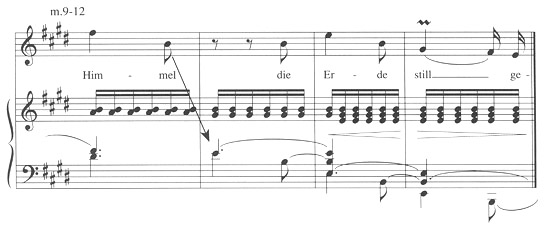
But above all it is the uncanny way in which these two fundamentally detached elements fall so naturally into perfect synthesis that causes us always to marvel. How better to represent the paradoxical antipody and attraction of opposites than in the attitude toward the roles of the ensemble members, permitting them their independence while ensuring concord as the product of their interaction. Moore seems to feel that in "Mondnacht," Schumann emulates Schubert. I have trouble citing any Schubert lied in which the behavioral roles of the voice and piano are conceived as we find them ingeniously so in "Mondnacht." It might be said that, if a model existed for Schumann to follow, it was Eichendorff's poem alone.
1Oskar Seidlin. "Eichendorff's Symbolic Landscape," PMLA LXXII (1957): 645-61.
2Gerald Moore, Poet's Love: The Song Cycles of Schumann (New York, 1981), 49.
3Lines ten and eleven pose the only question regarding this consistency, because weit ihre and flog durch die may be read, as Schumann's setting demonstrates, in a dactylic pattern ( ).
).
4Egon Schwartz, Joseph von Eichendorff (New York, 1972), 99.
5Lawrence Radner, Eichendorff: The Spiritual Geometer (Lafayette, Indiana, 1970), 13.
6Gerald Moore, Poet's Love, 47.
7Oskar Seidlin, 659.
8Robert Haven Schauffler, Florestan: The Life and Work of Robert Schumann (New York, 1945), 355. Seidlin would react furiously to this casual and perhaps misguided labeling. He would take it as an accusation that the poet indulged in freely gushing emotion of the type that eventually "vulgarized and cheapened" romanticism (p. 661). Seidlin hails Eichendorff as a genuine German romantic. "His writings follow a systematic cipher, his landscapes encode tangibly and visibly the theology of Christian doctrine. In his imagery he paints no pictures, but expresses the ontology of man's fate and existence. As a man and a believer, he is devout. Through the imaginative, yet deliberate, practice of art, he fulfills a ministry."


